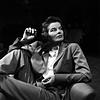Take a photo of a barcode or cover
informative
medium-paced
informative
slow-paced
Alison Weir is a top notch historian. I have not read a book of hers yet that I do not like. This is a deep dive into the life and times of Anne Boleyn, first the mistress of Henry VIII and then Queen. She had an interesting life, and her manipulations and intrigues were very entertaining. She really moved herself to the top of the world before it all came crashing down around her for the whims of a man. The lives of women in this era are so interesting to me. I really liked this book a lot.
dark
informative
sad
slow-paced
Moderate: Death, Death of parent
Last year I made my way through Weir’s Six Tudor Queens fiction series, and reading her nonfiction gave me that same rush. Anne Boleyn’s fall has fascinated me for years and I relished having an entire book dedicated to that period. If you enjoy nonfiction about the Tudor period, this book is an excellent read!
This book has a VERY special meaning to me as I bought this book from the gift shop at Hampton Court. Anne Boleyn, the amazing, incredible, life changing Anne Boleyn spent some of her royal life at Hampton Court. She graced those long decorative hallways with her spirit and elegance, holding her head up high and proud as Queen of England. It was also within these walls that she allegedly held some of her affairs (I say allegedly because most of the dates are so inaccurate and have been disproven!)
The Lady in the Tower focuses on the fall of Anne Boleyn. This is an area in which I am extremely passionate and have read a great deal about. Not that I’m not passionate about all of Anne’s life, but the final six months would have to be my area of special interest. So to buy this incredible book from Hampton Court just added that special meaning for me. To hold the book as I strolled through the halls of the Palace, perhaps even where Anne walked, sat, witnessing the views (similar) to what she saw. Absolutely awe inspiring.
As always Weir commands the use of English literate to not just give the facts, but to weave and portray an emotional, gut wrenching story of the tragic downfall of Anne. There are a lot of reasons as to why Anne fell; many simply related to the woman that she was. And what I love about Weir is that she does not try and portray Anne as a holy, saintly, completely innocent woman. Anne was a proud, vivacious, spirited woman with a temper, there is certainly no denying that! She was cruel and she was kind. She was who she was and for seven years that captivated Henry VIII… until they got married. Upon marriage Anne was expected to fall into the submissive role that Katherine of Aragon played – unfortunately that is just not who Anne Boleyn was and ultimately she payed the price for that. Her refusal to submit to Henry, her outspokenness, her temper, her ultimate inability to provide England with a male heir all worked together to bring about her downfall.
But there were others involved; Cromwell for a start was a huge player in Anne’s ultimate fall and execution. She argued and fought with Cromwell over a huge range of issues, especially the distribution of the wealth from the fall of the monasteries. Anne wanted it to go to the poor, to the furtherment of the reformation, to the universities and charities – Cromwell wanted it to go to the King and his treasuries. There were those about court, The Duke of Suffolk, the Duke of Norfolk and many others who all saw Anne as a threat to themselves, as to loud, to overreaching of the role of a woman and Queen and they quickly joined the Anti Boleyn faction. Anne was a woman of spirit, she liked to laugh, to flirt, to play and those against her used all of this in evidence to bring her down.
What I love about this book is the emotion weaved into every page. I read this book on the flight home from London. Once I picked it up I simply could not stop, there is no way you can put this book down so I suggest you read it when you have a long stretch of time free! I cried throughout this book, but I especially wept at the last moments of Anne’s life. These intricately researched, beautifully written details were written with such weight full emotion that I felt as though my heart was being squeezed. I sat in my seat on the plane crying, weeping, tissues crushed in one hand as I tried not to let my tears hit the pages. I failed and my tears stain the many pages of this wonderful book.
There was one paragraph in the book that really stood out to me; made me shutter and gasp in shock….
In 1905, a French doctor observed that a decapitated criminal’s eyelids and lips worked for five seconds before the face relaxed and the eyes rolled back, at which point he called out the man’s name, only to see the eyes fixing themselves on him and the pupils focusing before the lids fell and the pupils glazed over. The whole process had taken twenty-five to thirty seconds. In 1989, the face of a man decapitated in a car accident registered shock, then terror, then grief, as the living eyes looked directly at the witness before dimming. In 1956, two French doctors concluded: ‘Death is not instantaneous: every element survives decapitation. It is a savage vivisection.’ In 1983, another medical study found that ‘no matter how efficient the method of execution, at least two to three seconds of intense pain cannot be avoided’. However, once the spine is severed, the perception of pain recedes. Some victims have not responded at all to stimuli, so it must therefore be concluded that they were knocked unconscious by the impact of the blow, or fainted due to the dramatic loss in blood pressure, and felt virtually nothing, while others – including perhaps Anne Boleyn – did experience a few dreadful moments of awareness of what was happening.
When reading this I had to stop. It was the middle of the night, sitting in a plane and I cried, I wept and wept and wept. I pray to God above upon everything that is good in this world that Anne did not feel any pain. That her final moments were quick and painless and she knew nothing but happy memories.
This book inspired me to write my own piece about Anne Boleyn and her final days. It was such a huge source of inspiration and I have credited it heavily in my own writing. This book gave me the strength and the courage and the pure desire to write about Anne’s final nineteen days about this earth. And thanks to this book I have my own piece of writing (all 45 pages and 22 000 words!!) to treasure as my own.
I still use this book as my constant resource. I purposely bought the hardcover version as I knew I would be referring back to it many, many times and I was right. Everything I read about Anne now I refer back to this book. Every tiny detail, to the clothing she was wearing on certain dates, to the path she walked from the Queen’s lodgings to the scaffold, to her final prayer. This book is one of the best, well in my opinion, the BEST resource for Anne Boleyn’s downfall. I re read small sections of it regularly and find myself staring at the images contained within the pages often.
The Lady in the Tower focuses on the fall of Anne Boleyn. This is an area in which I am extremely passionate and have read a great deal about. Not that I’m not passionate about all of Anne’s life, but the final six months would have to be my area of special interest. So to buy this incredible book from Hampton Court just added that special meaning for me. To hold the book as I strolled through the halls of the Palace, perhaps even where Anne walked, sat, witnessing the views (similar) to what she saw. Absolutely awe inspiring.
As always Weir commands the use of English literate to not just give the facts, but to weave and portray an emotional, gut wrenching story of the tragic downfall of Anne. There are a lot of reasons as to why Anne fell; many simply related to the woman that she was. And what I love about Weir is that she does not try and portray Anne as a holy, saintly, completely innocent woman. Anne was a proud, vivacious, spirited woman with a temper, there is certainly no denying that! She was cruel and she was kind. She was who she was and for seven years that captivated Henry VIII… until they got married. Upon marriage Anne was expected to fall into the submissive role that Katherine of Aragon played – unfortunately that is just not who Anne Boleyn was and ultimately she payed the price for that. Her refusal to submit to Henry, her outspokenness, her temper, her ultimate inability to provide England with a male heir all worked together to bring about her downfall.
But there were others involved; Cromwell for a start was a huge player in Anne’s ultimate fall and execution. She argued and fought with Cromwell over a huge range of issues, especially the distribution of the wealth from the fall of the monasteries. Anne wanted it to go to the poor, to the furtherment of the reformation, to the universities and charities – Cromwell wanted it to go to the King and his treasuries. There were those about court, The Duke of Suffolk, the Duke of Norfolk and many others who all saw Anne as a threat to themselves, as to loud, to overreaching of the role of a woman and Queen and they quickly joined the Anti Boleyn faction. Anne was a woman of spirit, she liked to laugh, to flirt, to play and those against her used all of this in evidence to bring her down.
What I love about this book is the emotion weaved into every page. I read this book on the flight home from London. Once I picked it up I simply could not stop, there is no way you can put this book down so I suggest you read it when you have a long stretch of time free! I cried throughout this book, but I especially wept at the last moments of Anne’s life. These intricately researched, beautifully written details were written with such weight full emotion that I felt as though my heart was being squeezed. I sat in my seat on the plane crying, weeping, tissues crushed in one hand as I tried not to let my tears hit the pages. I failed and my tears stain the many pages of this wonderful book.
There was one paragraph in the book that really stood out to me; made me shutter and gasp in shock….
In 1905, a French doctor observed that a decapitated criminal’s eyelids and lips worked for five seconds before the face relaxed and the eyes rolled back, at which point he called out the man’s name, only to see the eyes fixing themselves on him and the pupils focusing before the lids fell and the pupils glazed over. The whole process had taken twenty-five to thirty seconds. In 1989, the face of a man decapitated in a car accident registered shock, then terror, then grief, as the living eyes looked directly at the witness before dimming. In 1956, two French doctors concluded: ‘Death is not instantaneous: every element survives decapitation. It is a savage vivisection.’ In 1983, another medical study found that ‘no matter how efficient the method of execution, at least two to three seconds of intense pain cannot be avoided’. However, once the spine is severed, the perception of pain recedes. Some victims have not responded at all to stimuli, so it must therefore be concluded that they were knocked unconscious by the impact of the blow, or fainted due to the dramatic loss in blood pressure, and felt virtually nothing, while others – including perhaps Anne Boleyn – did experience a few dreadful moments of awareness of what was happening.
When reading this I had to stop. It was the middle of the night, sitting in a plane and I cried, I wept and wept and wept. I pray to God above upon everything that is good in this world that Anne did not feel any pain. That her final moments were quick and painless and she knew nothing but happy memories.
This book inspired me to write my own piece about Anne Boleyn and her final days. It was such a huge source of inspiration and I have credited it heavily in my own writing. This book gave me the strength and the courage and the pure desire to write about Anne’s final nineteen days about this earth. And thanks to this book I have my own piece of writing (all 45 pages and 22 000 words!!) to treasure as my own.
I still use this book as my constant resource. I purposely bought the hardcover version as I knew I would be referring back to it many, many times and I was right. Everything I read about Anne now I refer back to this book. Every tiny detail, to the clothing she was wearing on certain dates, to the path she walked from the Queen’s lodgings to the scaffold, to her final prayer. This book is one of the best, well in my opinion, the BEST resource for Anne Boleyn’s downfall. I re read small sections of it regularly and find myself staring at the images contained within the pages often.
I enjoyed this book. I really like Alison Weir's writing style. She uses primary sources and interweaves amongst it her own views. I enjoy reading about Anne Boleyn, I find her fascinating. This particular book discusses the fall of Anne Boleyn and documents from when she was in trouble, nothing really before hand. It is done in great detail, very well written.
Helps to establish the surroundings of the execution of Anne’s death. Well written and helped me open my eyes to new theories.
I only knew of the story of her daughter, Elizabeth I, from a TV show called Reign. And they merely mentioned small details about her mother, so I never considered knowing more about her parents until I found this book. The details were compelling and engaging, yet so controversial it deepened my gratitude for living in this generation.
In general, this family's wild af. But would definitely recommend this book.
In general, this family's wild af. But would definitely recommend this book.
Interesting analysis of the last four months of the life Anne Boleyn. However, if you don't know anything about her first 34 years, you will be confused. Not her best work.
Wanted to like it - the style of writing is so convoluted I just couldn't process it. Read 1/5 of it. Held on for the rest of the year, but it's time to put it in the didn't bother reading pile. If you read it, good luck!








